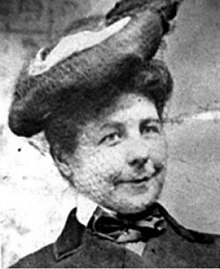Mary Anderson is considered the inventor of the windscreen wiper. We can relate her and this invention to other everyday ones made by women in the late 19th and 20th centuries: the dishwasher (Josephine Cochrane), the hypodermic syringe (Letitia Geer), the coffee pot (Melitta Bentz), the disposable nappy (Marion Donovan), the lifeboat (Maria Beasley), the ink pen (Bette Nesmith Graham) or the bra (Mary Phelps Jacob).

Mary Anderson
Alabama (United States), 19-02-1866 — Birmingham (United States), 27-06-1953
Període d'activitat: 1902 — 1920
Classificació geogràfica: Amèrica > Estats Units
Moviments socio-culturals
Edat contemporània
Grups per àmbit de dedicació
Tecnòlogues > Inventores
Professionals / Altres grups > Empresàries / Directives / Administradores
Context de creació femenina
Ressenya
She invented the windscreen wiper, creating the first active safety system used in vehicles. In this way, vision and, therefore, driving was not affected. She patented her invention in 1903.
Activitats
Justificacions
Biografia
Mary Anderson was born in the Greene County, in Alabama, at the beginning of the Reconstruction era in 1866. In 1889, she moved with her widowed mother and her sister to the growing town of Birmingham, Alabama. She built the Fairmont Apartments on Highland Avenue shortly after moving in. In 1893, Mary Anderson moved west to Fresno, California, where, until 1898, she managed a cattle ranch and a vineyard.
On a visit to New York City, in the winter of 1902, she took the tram and noted that throughout the ride, the driver had to stop and get out continually to wipe dirt, water, and ice off the windshield; she also observed that the driver left the windows half open due to difficulties in keeping the windshield clean. This was a waste of time for the driver and travellers. A day after, she sketched a diagram of the elementary sweeping device. When she returned to Alabama, she hired a designer to draw a hand-operated device to keep the windshield clear and got a local company to produce a working model.
In 1903, she applied for and was granted a 17-year patent for the windshield wiper. The device she designed consisted of a lever, installed inside the vehicle, that controlled a plate of tough rubber on the outside of the windshield. The lever could be activated to make the spring-loaded metal arm move back and forth across the windshield, repeatedly. A counterweight was used to ensure contact between the blade and the window. Similar devices had been made before, but Anderson's was the first to be effective. Her system had a single arm supported at the top and centre of the glass.
In 1905, Mary Anderson tried to sell the rights of her invention to a Canadian company, but they did not accept her offer, arguing that they did not consider the invention to have sufficient commercial value to warrant going into its production. During her struggle to sell her invention, Henry Ford appeared on the scene, who came into contact with this invention. True to his innovative side, he interpreted its utility, which was initially tested on Ford T's with windshields.
After the patent expired in 1920, and the automobile manufacturing business grew exponentially, Anderson's windshield wiper design became standard equipment. In 1922, Cadillac became the first car manufacturer to adopt it as standard equipment.
Mary Anderson resided in Birmingham, where she continued to manage the Fairmont Apartments until her death at the age of 87.
Mary Anderson's windshield wiper invention is mentioned in Season 17, Episode 19: "Girls Just Want to Have Sums", of the Simpsons cartoon.
It is also briefly mentioned on the British TV show QI (Very Interesting); Season 10, Episode 16 - "Just the Job." https://es.wikipedia.org/wiki/Mary_Anderson_ (inventor) (16/01/2022)
Obres
-In 1903, she applied for and was granted a 17-year patent for the windscreen wiper.
(More information on the patent: M. Anderson. Window cleaning device. https://patents.google.com/patent/US743801)
Enfocament Didàctic
She can be studied in Technology, in the block of contents about solving technological problems and technical communication, seen in 1st, 2nd and 3rd of ESO; in the block of contents about structures and mechanisms, seen in 2nd and 3rd of ESO; and, in the block of contents about control and robotics, seen in 4th of ESO. She can also be studied in English, when working the text of her patent. (Link to the document with the images and text of her patent: Mary Anderson. Window cleaning device. https://patents.google.com/patent/US743801)